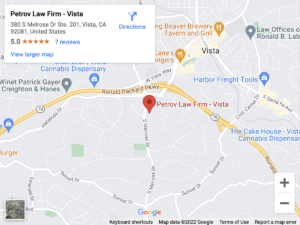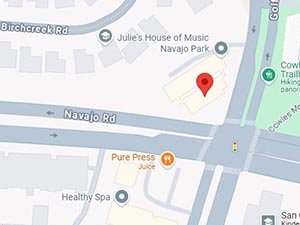
Causation is the reason why something occurred. It is one of the legal elements you must prove to recover damages for an accident or personal injury. However, causation can be one of the most difficult elements to prove in a personal injury case.
California tort laws govern most personal injury claims in Vista, CA. A tort is conduct that causes harm or injury to another person. Proving the other party is responsible for the act or omission that led to your injury requires creating a chain of causation from the party’s act or omission directly to your injury.
Proving Causation in a Vista Personal Injury Case

Car accidents, medical malpractice, premises liability, and slip and fall accidents are common examples of negligence claims. The legal elements you must prove to win your case are:
- Duty of Care – You must prove the defendant owed you a legal duty to act with a specific level of care.
- Breach of Duty – The second thing you must prove is that the defendant’s actions failed to meet the level of care required for the situation.
- Causation – The next element is to prove that the defendant’s conduct breached that duty by directly and proximately causing your injuries.
- Damages – Finally, you must prove that the defendant’s negligence caused you to sustain damages, such as physical injuries, financial losses, and emotional distress.
To prove causation, you must prove the defendant’s conduct caused your injury. However, you must first prove the conduct breached the duty of care. The level of care is based on what a “reasonable person” would have done given the same circumstances.
You must also prove your case by a preponderance of the evidence. In other words, the level of the burden of proof for your case is that there is a greater chance the defendant is guilty than not. The jury must believe that there is more than a 50% chance that the defendant acted negligently in causing your injuries.
Establishing Direct and Proximate Cause for a Personal Injury Case
Proving causation involves establishing both “direct” and “proximate” causes. While the two types of causes are similar, there are differences.
The chain of causation begins by proving a direct or actual cause. In some cases, the actual cause of an injury is apparent.
For example, a person runs a red light and hits another car. The act of running the red light was the direct cause of the car accident. The collision would not have occurred “but for” the other person failing to yield the right of way.
However, direct causation might not be as apparent in some cases. For example, the insurance company might dispute liability if you cannot prove that the defendant’s conduct was the direct cause of your injury with evidence.
Proving the actual cause of an injury is only one step. You must also prove proximate cause, which could be more difficult. The other person’s conduct must have been a substantial factor in why you were injured.
Proximate cause also requires that the plaintiff’s injuries were a natural and foreseeable consequence of the defendant’s conduct. In other words, the person could reasonably conclude that taking such action could lead to causing an injury to another person.
Typically, individuals are not liable for damages sustained by an injury victim if they could not link foreseeable injuries to foreseeable conduct. A defendant might not be held liable for circumstances out of their control, except in some cases involving strict or vicarious liability.
What Evidence Can I Use To Prove Causation for an Injury Claim?
The evidence must prove the defendant caused your injury. The strength of your evidence directly impacts the outcome of your case.
Therefore, you need an experienced lawyer working to gather evidence to build a solid case for causation and fault. It improves your chance of recovering fair compensation for damages.
Evidence that your attorney may use to prove causation includes:
- Videos of the accident as it occurred, such as traffic camera footage or surveillance tapes
- Photographs from the accident scene
- Copies of the accident or police reports
- Physical evidence from the accident scene
- Testimony from the parties involved and eyewitnesses
- Medical records describing your injuries
- Evidence from a vehicle’s black box and data recording systems
- Reports, research, and opinions of expert witnesses
- The evidence produced by accident reconstructionists
Because the facts and circumstances of your case are unique, there could be other types of evidence your attorney uses to prove causation. Once you prove the other party breached their duty of care and that breach of duty caused your injury, you can demand compensation for damages.
Damages You Could Receive for a Personal Injury Case
Damages in your case include the financial losses you incurred because of the injury. Economic damages include the cost of medical treatment and your loss of income. They also include out-of-pocket expenses and diminished earning capacity.
Your damages also include the pain and suffering you experience. These non-economic damages can include physical pain and emotional suffering. However, they also include a decrease in your quality of life, permanent impairments, and mental anguish.
Schedule a Free Consultation With Our Vista Personal Injury Lawyers
Our legal team helps you receive the compensation you deserve when another party causes you injury or harm. Contact or call Petrov Personal Injury Lawyers at (619) 344-0360 to schedule a free consultation with one of our experienced personal injury attorneys in Vista, CA.


